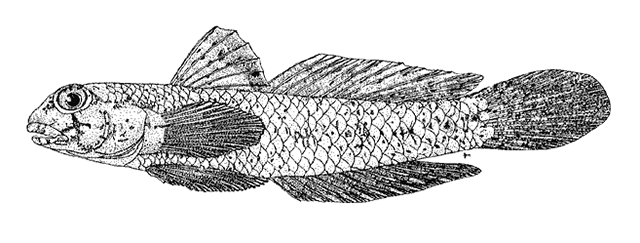| Gobiidae (Gobies), subfamily: Gobionellinae |
| 3.66 cm SL (male/unsexed) |
|
demersal; marine; depth range 0 - 1 m |
| Western Pacific: Australia. |
|
Dorsal spines (total): 7-7; Dorsal soft rays (total): 11-11; Anal spines: 1-1; Anal soft rays: 11-12. Distinguished by the following characteristics: small Gnatholepis (up to 35.4 mm SL) lacking scales on side of cheek, opercle and predorsal midline, few cycloid scales present on pectoral fin base and on breast; no distinct flap on end of lower lip (low fold may be present); no distinct canine or enlarged teeth; second dorsal fin rays I,11; anal fin rays I,11-12 (usually I,12); pectoral rays 15-19 (usually 17); lateral scales 26-28, ctenoid; predorsal scales absent from nape midline, scales on side of head reaching to nearly behind eyes; body pale with dusky speckling and mid-lateral row of six dusky blotches and horizontal row of darker spots and short streaks, an irregular cross-shaped dark mark on cheek extending down from eye, pupil-sized brown spot just above mid-point of caudal fin base, males with small black spot on rear part of first dorsal fin (Ref. 92171). |
| Occurs in shallow water, generally in less than 0.5 m; at least one lot was collected from a brackish habitat (Ref. 41653). |
|
Not Evaluated (N.E.) Ref. (130435)
|
| harmless |
Source and more info: www.fishbase.org. For personal, classroom, and other internal use only. Not for publication.

